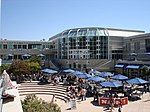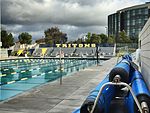The University of California, San Diego (UC San Diego or, colloquially, UCSD) is a public land-grant research university in San Diego, California. Established in 1960 near the pre-existing Scripps Institution of Oceanography, UC San Diego is the southernmost of the ten campuses of the University of California, and offers over 200 undergraduate and graduate degree programs, enrolling 33,343 undergraduate and 9,533 graduate students. The university occupies 2,178 acres (881 ha) near the coast of the Pacific Ocean, with the main campus resting on approximately 1,152 acres (466 ha). UC San Diego is ranked among the best universities in the world by major college and university rankings.UC San Diego consists of four academic divisions (Arts and Humanities, Biological Sciences, Physical Sciences, and Social Sciences), and seven graduate and professional schools (Jacobs School of Engineering, Rady School of Management, Scripps Institution of Oceanography, School of Global Policy and Strategy, School of Medicine, Skaggs School of Pharmacy and Pharmaceutical Sciences, and the newly established Wertheim School of Public Health and Human Longevity Science). The university has seven undergraduate residential colleges (Revelle, John Muir, Thurgood Marshall, Earl Warren, Eleanor Roosevelt, Sixth, and Seventh). UC San Diego received over 140,000 applications for Fall 2021, making it the second most applied-to university in the United States. UC San Diego Health, the region's only academic health system, provides patient care, conducts medical research and educates future health care professionals at the UC San Diego Medical Center, Hillcrest, Jacobs Medical Center, Moores Cancer Center, Sulpizio Cardiovascular Center, Shiley Eye Institute, Institute for Genomic Medicine, Koman Family Outpatient Pavilion and various express care and urgent care clinics throughout San Diego.The university operates 19 organized research units (ORUs), including the Center for Energy Research, Qualcomm Institute, San Diego Supercomputer Center and the Kavli Institute for Brain and Mind, as well as eight School of Medicine research units, six research centers at Scripps Institution of Oceanography and two multi-campus initiatives, including the Institute on Global Conflict and Cooperation. UC San Diego is also closely affiliated with several regional research centers, such as the Salk Institute, the Sanford Burnham Prebys Medical Discovery Institute, the Sanford Consortium for Regenerative Medicine, and the Scripps Research Institute. It is classified among "R1: Doctoral Universities – Very high research activity". According to the National Science Foundation, UC San Diego spent $1.354 billion on research and development in fiscal year 2019, ranking it 6th in the nation.UC San Diego is considered one of the country's Public Ivies. As of February 2021, UC San Diego faculty, dozens of researchers and alumni have won Nobel Prizes, the second most of any UC campus, as well as three Fields Medals, eight National Medals of Science, eight MacArthur Fellowships, and three Pulitzer Prizes. Additionally, of the current faculty, 29 have been elected to the National Academy of Engineering, 70 to the National Academy of Sciences, 45 to the Institute of Medicine and 110 to the American Academy of Arts and Sciences.





